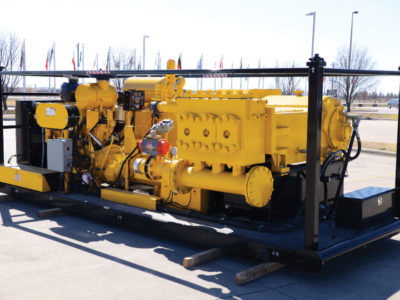Mud pumps are a vital part of pipeline drilling projects. But with mud pumps, you have a decision to make: Should you use an onboard or a stand-alone mud pump? Both can get the job done well, but what’s the best option for your operation? To answer those questions, we have to look at three different factors: productivity, transportation and space.
Productivity goals
First, you have to consider your productivity goals. To maximize the capacity and productivity of your pipeline directional drills, you need a consistent flow of drilling fluid that a mud pump can provide. However, there’s a difference in size between onboard mud pumps and stand-alone ones.
For example, on the Vermeer D220x300 S3 Navigator® horizontal directional drill, the maximum drilling fluid flow is 345 gpm (1,306 L/min). An onboard mud pump most likely won’t be able to reach that maximum flow but a stand-alone pump could. At 100% efficiency, the Vermeer SA400 Tier 4i (Stage IIIB) high-pressure mud pump has a maximum flow of 550 gpm (2,082 L/min), which would allow you to maximize the fluid flow on your drill.
If you lower your fluid flow, you’re slowing your downhole speed and your thrust/pullback speed. You can get by with a smaller onboard mud pump, but you’ll have to take things slower and be patient as you drill.
“The higher the flow, the higher the productivity,” said Tod Michael, a Vermeer product manager for trenchless products. “If you’re drilling a smaller diameter bore, a small onboard pump could handle the job. But if you need to increase your fluid, have a higher gpm flow downhole or are drilling a 24-inch (60.9 cm) diameter or larger, a stand-alone mud pump is a good option.”
With that increase in fluid or flow speed, you can increase your pullback speed and drill faster, helping make your time on the jobsite productive.
Cost of transportation
Along with productivity factors to consider, you also have to think about the additional transportation costs.
A stand-alone mud pump means there’s more equipment to haul to the jobsite. Often, this requires an additional truck to transport it, since you also have to haul your drill, reclaimer and drilling fluid too. Another truck means extra costs and is something to be aware of beforehand.
“I’d advise weighing the transportation costs with your productivity advantage,” suggested Michael. “If you find you can live with lower productivity because it’s more economical to haul only one truck, that’s great. If you find it’s better to haul two trucks of equipment to maximize your productivity, that’s great too. It all comes down to your preference and your specific operation.”
It’s worth it to do the math for your operation and decide if owning a mud pump is a valid option.
Space on the jobsite
One last thing to consider before you make a decision between onboard or stand-alone mud pumps is the space on the jobsite. Think about the typical amount of room you have for equipment. Will you have space for a stand-alone mud pump each time?
A key feature about stand-alone mud pumps is the extra storage and space it provides. But in order to maximize that storage, you need space for it.
“Your jobsite space may vary from site to site, but ensuring that you will have room for a mud pump is an important factor to remember as you plan the project,” said Michael. “Usually, if contractors have the space, they’ll opt to have a stand-alone mud pump onsite.”
At the end of the day, the decision is yours. Considering the productivity pros and cons, the additional transport costs and the space on your jobsite can help make the decision simpler but it all depends on your specific needs and how you operate on a daily basis.
For more information on Vermeer mud pumps, visit vermeer.com or reach out to your local Vermeer dealer.
Vermeer Corporation reserves the right to make changes in engineering, design and specifications; add improvements; or discontinue manufacturing at any time without notice or obligation. Equipment shown is for illustrative purposes only and may display optional accessories or components specific to their global region. Please contact your local Vermeer dealer for more information on machine specifications.
Vermeer, the Vermeer logo and Navigator are trademarks of Vermeer Manufacturing Company in the U.S. and/or other countries.
© 2021 Vermeer Corporation. All Rights Reserved.
